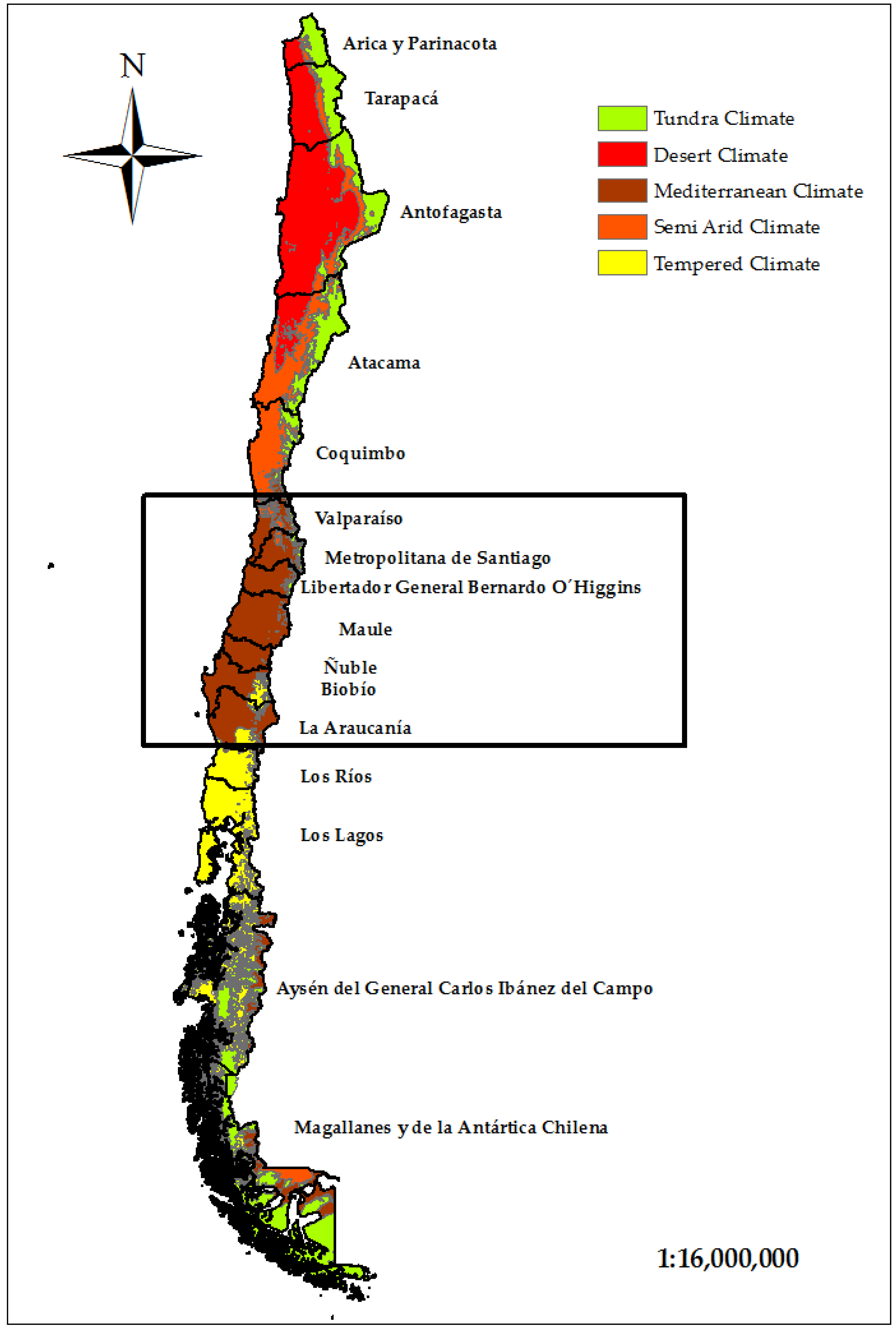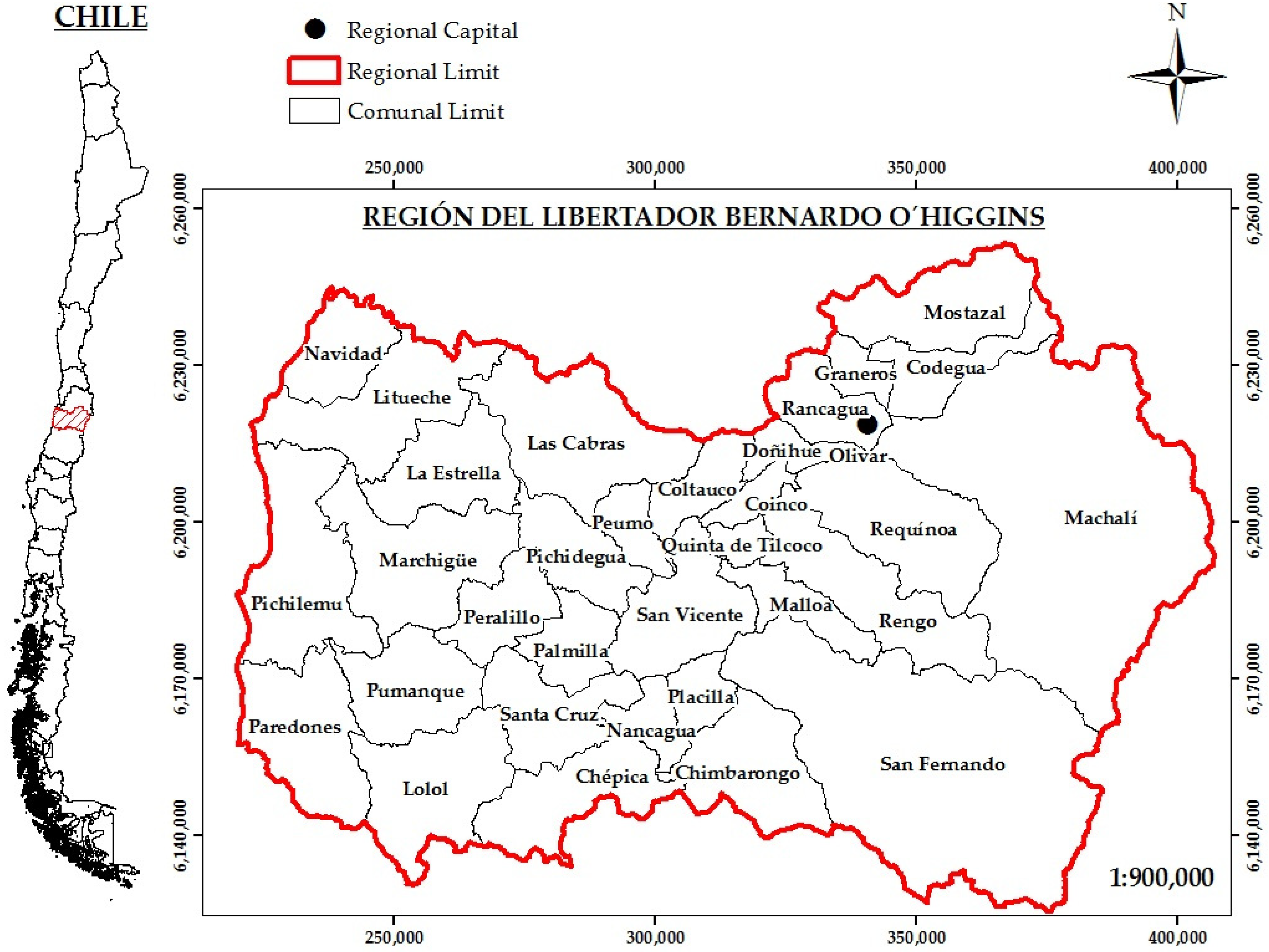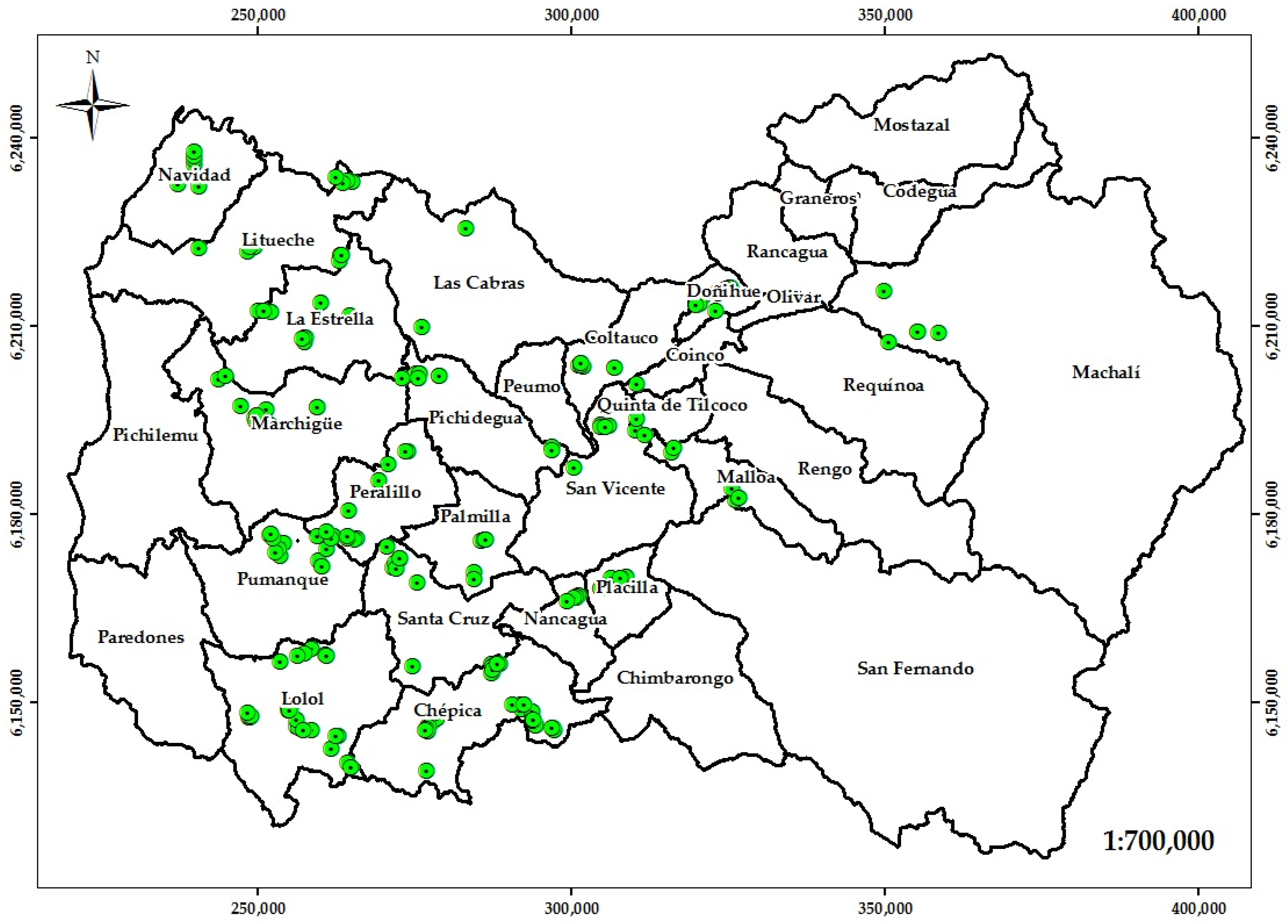Characterization of Small Forest Landowners as a Basis for Sustainable Forestry Management in the Libertador General Bernardo O’Higgins Region, Chile
Abstract
1. Introduction
2. Materials and Methods
2.1. Study Area
2.2. Data Collection
“A person who has the title deed for one or more rural properties with the presence of native forest, with a combined area of no more than 200 ha; whose assets do not exceed the equivalent of 3500 development units (accounting unit used in Chile to re-value savings in line with inflation rates so the money maintains its purchasing power); equivalent to 122,500 euros, whose income derives mainly from agricultural or forestry activities and who works directly on the land, on their property or on another property belonging to third parties.”
2.3. Statistical Analysis
2.4. Validation of Typologies and Work Lines
3. Results and Discussion
3.1. Spatial Distribution of Small Forest Landowners in the Region
3.2. Identification of Landowner Groups
3.2.1. Initial Variables
3.2.2. Results of the Multiple Correspondence Analysis
3.2.3. Grouping of Landowners
4. Conclusions
Author Contributions
Funding
Acknowledgments
Conflicts of Interest
Appendix A
| FORM no. | DATE: | SURVEYOR: | ||||
| COMMUNE | UTM N | |||||
| LOCALITY | UTM E | |||||
| ADDRESS | DISTANCE TO PAVED ROAD | |||||
| ALTITUDE | CONTACT | |||||
| SLOPE | ||||||
| IDENTIFICATION OF THE HEAD OF HOUSEHOLD | ||||||
| NAME | AGE | MARITAL STATUS | MAIN ECONOMIC ACTIVITY | EDUCATION | ||
| CHARACTERISTICS OF THE FAMILY GROUP | ||||||
| NAME | AGE | MARITAL STATUS | MAIN ECONOMIC ACTIVITY | EDUCATION | ||
| CHARACTERISTICS OF THE PROPERTY | CHARACTERIZATION OF THE NATIVE FOREST | |||||
| LANDHOLDING | STRUCTURE | ADULT FOREST | ||||
| OWN (ROLE) | RENEWAL | |||||
| SUCCESSION | ADULT FOREST RENEWAL | |||||
| ADULT FOREST SCRUB | ||||||
| LEASED | MAIN SPECIES | |||||
| RIGHT TO USUFRUCT | SCLEROPHYLLOUS | |||||
| FREE CONCESSION | HUALO OAK | |||||
| CHILEAN CEDAR | ||||||
| SIZE OF THE PROPERTY | CHILEAN PALM | |||||
| AREA OF NATIVE FOREST | FOREST TYPE | EVERGREEN, OTHER | ||||
| CHARACTERIZATION OF PRODUCTIVE SUBSYSTEMS (Indicate the Main One) | ||||||
| AGRICULTURAL SUBSYSTEM (Indicate areas) | LIVESTOCK SUBSYSTEM | |||||
| FARMLAND | FOREST SUBSYSTEM | |||||
| VINES | AGROFORESTRY SUBSYSTEM | |||||
| FRUIT TREES | OTHER | |||||
| WATER AVAILABILITY INDICATE WHETHER THE WATER FOR CONSUMPTION AND IRRIGATION COMES FROM A WELL, WATERWHEEL, ETC. | ||||||
| YIELDS. EXTRACTION OF TIMBER AND NON-TIMBER FOREST PRODUCTS. INDICATE WHICH ONES AND WHAT QUANTITY | ||||||
| NUMBER AND TYPE OF ANIMAL UNITS | ||||||
| ANIMAL-DRAWN AND MECHANICAL TRACTION EQUIPMENT. | ||||||
| GENERAL INFRASTRUCTURE (DESCRIBE) | ||||||
References
- MacDicken, K.G.; Sola, P.; Hall, J.E.; Sabogal, C.; Tadoum, M.; Wasseige, C. Global progress toward sustainable forest management. For. Ecol. Manag. 2015, 352, 47–56. [Google Scholar] [CrossRef]
- Castillo, M.; Molina, J.R.; Rodríguez y Silva, F.; García-Chevesich, P.; Garfias, R. A system to evaluate fire impacts from simulated fire behavior in Mediterranean areas of Central Chile. Sci. Total Environ. 2016, 579, 1410–1418. [Google Scholar] [CrossRef] [PubMed]
- Armesto, J.J.; Arroyo, M.; Hinojosa, L.F. The Mediterranean environment of Central Chile. In The Physical Geography of South America; Velben, T.T., Young, K.R., Orme, A.R., Eds.; Oxford University Press: New York, NY, USA, 2007; pp. 184–199. [Google Scholar]
- Bastin, J.F.; Berrahmouni, N.; Grainger, A.; Maniatis, D.; Mollicone, D.; Moore, R.; Patriarca, C.; Picard, N.; Sparrow, B.; Abraham, E.M.; et al. The extent of forest in dryland biomes. Science 2017, 356, 635–638. [Google Scholar] [CrossRef]
- Huang, J.; Yu, H.; Guan, X.; Wang, G.; Guo, R. Accelerated dryland expansion under climate change. Nat. Clim. Chang. 2016, 6, 166–171. [Google Scholar] [CrossRef]
- Cubbage, F.; Harou, P.; Sills, E. Policy instruments to enhance multi-functional forest management. For. Policy Econ. 2007, 9, 833–851. [Google Scholar] [CrossRef]
- Garfias, R.; Soto, M.C.; Gozalvo, F.R.; Alonso, A.V.; Intveen, H.B.; Cerrillo, R.N. Remants of schlerophyllous forest in the mediterranean zone of central Chile: Characterization and distribution of fragments. Interciencia 2018, 43, 655–663. [Google Scholar]
- Bahamondez, A.; Rivas, E. Comunidades vinculadas a los Recursos Vegetacionales. In Bosque Nativo, Comunidades y Cambio Climático; Bahamondez, A., Ed.; European Union Commission: Brussels, Belgium, 2016; pp. 87–112. [Google Scholar]
- FAO. State of the Forests in the World: Forest Pathways to Sustainable Development; Food and Agriculture Organization of United Nations: Roma, Italy, 2018; p. 153. [Google Scholar]
- Estrada, C.; Irisity, F.; Hernández, G.; Torres, J. Casos Ejemplares de Manejo Forestal Sostenible en Chile, Costa Rica, Guatemala y Uruguay; Food and Agriculture Organization of United Nations: Roma, Italy, 2016; p. 236. [Google Scholar]
- Aquino, V.; Camarena, F.; Julca, A.; Jiménez, J. Multivariate characterization of tarwi (Lupinus mutabilis Sweet) producing farms of the Mantaro Valley, Peru. Sci. Agropecu. 2018, 9, 269–279. [Google Scholar] [CrossRef]
- Kuivanen, K.; Álvarez, S.; Michalscheck, M.; Adjei-Nsiah, S.; Descheemaeker, K.; Mellon-Bedi, S.; Groot, J.C. Characterising the diversity of smallholder farming systems and their constraints and opportunities for innovation: A case study from the Northern Region, Ghana. NJAS Wagening. J. Life Sci. 2016, 78, 153–166. [Google Scholar] [CrossRef]
- Carmona, A.; Nahuelhual, L. Tipificación y caracterización de sistemas prediales: Caso de estudio en Ancud, Isla de Chiloé. Classification and characterization of farming systems: Case study in the municipality of Ancud, Chiloé Island. Agro Sur 2009, 37, 189–199. [Google Scholar] [CrossRef]
- González-Redondo, P.; Delgado-Pertíñez, M.; Toribio, S.; Ruiz, F.A.; Mena, Y.; Caravaca, F.P.; Castel, J.M. Characterisation and typification of the red-legged partridge (Alectoris rufa) game farms in Spain. Span. J. Agric. Res. 2013, 8, 624–633. [Google Scholar] [CrossRef]
- Köbrich, C.; Rehman, T.; Khan, M. Typification of farming systems for constructing representative farm models: Two illustrations of the application of multi-variate analyses in Chile and Pakistan. Agric. Syst. 2003, 76, 141–157. [Google Scholar] [CrossRef]
- Mądry, W.; Gozdowski, D.; Roszkowska-Mądra, B.; Castel, J.M.; Mena, Y.; Hryniewski, R. An overview of farming system typology methodologies and its use in the study of pasture-based farming system: A review. Span. J. Agric. Res. 2013, 11, 316–326. [Google Scholar] [CrossRef]
- Carrillo Anzures, F.; Acosta Mireles, M.; Flores Ayala, E.; Torres Rojo, J.M.; Sangerman-Jarquín, D.M.; González, L.; Buendía, E. Caracterización de productores forestales en 12 estados de la República Mexicana. Rev. Mex. Cienc. Agric. 2017, 8, 1561–1573. [Google Scholar] [CrossRef]
- Censo de Chile. 2017. Available online: http://www.censo2017.cl/ (accessed on 21 September 2019).
- Región del Libertador Bernardo O’Higgins. Available online: https://www.bcn.cl/siit/nuestropais/region6/ (accessed on 20 June 2019).
- Vega, N. La Entrevista Como Fuente De Información: Orientaciones Para Su Utilización. In Memoria e Historia del Pasado Reciente. Problemas Didácticos y Disciplinares; Alonso, L., Falchini, A., Eds.; Secretaría de Extensión, Universidad Nacional del Litoral: Santa Fe, Argentina, 2009; pp. 51–77. [Google Scholar]
- Wei, X.; Allen, N.J.; Liu, Y. Disparity in organizational research: How should we measure it? Behav. Res. Methods 2016, 48, 72–90. [Google Scholar] [CrossRef] [PubMed]
- Martín-Fernández, S.; Martinez-Falero, E. Sustainability assessment in forest management based on individual preferences. J. Environ. Manag. 2018, 206, 482–489. [Google Scholar] [CrossRef] [PubMed]
- Herrmann, T.M.; Torri, M.C. Changing forest conservation and management paradigms: Traditional ecological knowledge systems and sustainable forestry: Perspectives from Chile and India. Int. J. Sustain. Dev. World Ecol. 2009, 16, 392–403. [Google Scholar] [CrossRef]
- Li, Y.; Mei, B.; Linhares-Juvenal, T. The economic contribution of the world’s forest sector. For. Policy Econ. 2019, 100, 236–253. [Google Scholar] [CrossRef]
- Watson, R.T.; Noble, I.R.; Bolin, B.; Ravindranath, N.H.; Verardo, D.J.; Dokken, D.J. Land Use, Land-Use Change, and Forestry, Intergovernmental Panel on Climate Change (IPCC) 2000; Cambridge University Press: New York, NY, USA, 2000; p. 388. [Google Scholar]
- Agrawal, A.; Chhatre, A.; Hardin, R. Changing governance of the world’s forests. Science 2008, 320, 1460–1462. [Google Scholar] [CrossRef]
- Newton, P.; Schaap, B.; Fournier, M.; Cornwall, M.; Rosenbach, D.W.; DeBoer, J.; Whittemore, J.; Stock, R.; Yoders, M.; Brodnigc, G.; et al. Community forest management and REDD+. For. Policy Econ. 2015, 56, 27–37. [Google Scholar] [CrossRef]
- Lee-Cortés, J.; Delgadillo-Macías, J. Territorial potential as factor of development, rural management model. Agric. Soc. Desarro. 2018, 15, 191–213. [Google Scholar]
- Aguilar, J.; Altamirano, J.; Rendón, R. Del Extensionismo Agrícola a las Redes de Innovación Rural 2010; Universidad Autónoma de Chapingo: Texcoco, Mexico, 2010; p. 282. [Google Scholar]
- Aguilar Gallegos, N.; Olvera Martínez, J.A.; Martínez González, E.G.; Aguilar Ávila, J.; Muñoz Rodríguez, M.; Santoyo Cortés, H. La intervención en red para catalizar la innovación agrícola. Redes Rev. Hisp. Anal. Redes Soc. 2017, 28, 9–31. [Google Scholar]



| Specialty | Institution |
|---|---|
| Forestry Engineer; Diploma of Specialization in Silviculture | University of Chile |
| Forestry Engineer; Doctor in Forestry Science | University of Chile |
| Veterinarian; Doctorate in Agrarian Economy | University of Chile |
| Veterinarian; Technical head of PRODESAL; Specialist in rural development | Local development program, Lolol |
| Agricultural technician; Technician PRODESAL; Specialist in rural development | Local development program, Chépica |
| Forestry Engineer; Head of Forestry Department | National Forestry Corporation |
| Forestry Engineer; Forest Extension Specialist | National Forestry Corporation |
| Commune | Number of SFLs | Area of Native Forest (ha) | Commune | Number of SFLs | Area of Native Forest (ha) |
|---|---|---|---|---|---|
| Chépica | 37 | 545.3 | Nancagua | 5 | 207 |
| Coinco | 1 | 8 | Navidad | 6 | 41.5 |
| Coltauco | 7 | 114.8 | Palmilla | 5 | 34.5 |
| Doñihue | 12 | 260.3 | Peralillo | 12 | 119.3 |
| La Estrella | 9 | 238 | Pichidegua | 11 | 203 |
| Las Cabras | 2 | 61 | Placilla | 8 | 211.3 |
| Litueche | 14 | 135.3 | Pumanque | 15 | 403.25 |
| Lolol | 28 | 702 | Quinta de Tilcoco | 1 | 10 |
| Machalí | 4 | 48.1 | Requínoa | 1 | 0.5 |
| Malloa | 6 | 61.8 | San Vicente | 8 | 79.5 |
| Marchigüe | 11 | 260 | Santa Cruz | 9 | 293.36 |
| Total SFLs | 211 | Total area | 4035.81 | ||
| Variable | Dimension | Mean | Variable | Dimension | Mean | ||||
|---|---|---|---|---|---|---|---|---|---|
| 1 | 2 | 3 | 1 | 2 | 3 | ||||
| AG | 0.257 | 0.145 | 0.416 | 0.273 | AU | 0.375 | 0.249 | 0.049 | 0.224 |
| EA | 0.320 | 0.230 | 0.363 | 0.304 | FS | 0.106 | 0.024 | 0.056 | 0.062 |
| ED | 0.187 | 0.204 | 0.260 | 0.217 | IN | 0.181 | 0.190 | 0.086 | 0.152 |
| PA | 0.211 | 0.431 | 0.240 | 0.294 | FP | 0.062 | 0.132 | 0.010 | 0.068 |
| NFA | 0.153 | 0.364 | 0.267 | 0.261 | MP | 0.145 | 0.085 | 0.145 | 0.125 |
| MPS | 0.477 | 0.273 | 0.155 | 0.302 | TR | 0.208 | 0.187 | 0.244 | 0.213 |
| WS | 0.268 | 0.183 | 0.185 | 0.212 | PCI | 0.320 | 0.230 | 0.363 | 0.304 |
| Variables | Typologies | |||
|---|---|---|---|---|
| Elderly SFLs | Retired SFLs | Largest SFLs | Middle-Aged SFLs | |
| Number of SFLs | 93 | 34 | 15 | 69 |
| 1. Average age of the head of household | 71 | 60 | 65 | 52 |
| 2. Education level | Basic level, not completed | Basic level, not completed | Basic level, not completed | Basic level, completed |
| 3. Average property area (ha) | 28 | 11 | 117 | 15 |
| 4. Average area of native forest (ha) | 15 | 8 | 95 | 11 |
| 5. Main economic activity | Full-time work on the property | Retired | Full-time work on the property | Full-time work on the property |
| 6. Main productive subsystem | Livestock | None | Livestock | Livestock |
| 7. Type of animal unit | Sheep | None | Sheep | Sheep |
| 8. Water for agriculture and livestock | Well | None | Well | Well |
| Typology | Family Members and Activities |
|---|---|
| Elderly SFLs | 52%, 1 or 2 members: activities related to the property. 48%, over 2 members: 23% students; 13% engaged in activities related to the property; 64% other activities |
| Retired SFLs | 56%, 1 or 2 members: retired. 44%, over 2 members: 23% students; 6% engaged in activities related to the property; 23% other full-time activities |
| Largest SFLs | 66%, 1 or 2 members: activities related to the property 34%, over 2 members: 100% engaged in activities related to the property; |
| Middle-aged SFLs | 39%, 1 or 2 members: activities related to the property. 61%, over 2 members: 25% students, 16% engaged in activities related to the property. |
| Variables | Typology | |||
|---|---|---|---|---|
| Elderly SFLs | Retired SFLs | Largest SFLs | Middle-Aged SFLs | |
| SFLs who extract forest products: %/no./SD | 63/59/0.05 | 44/22/0.085 | 73/11/0.11 | 50/35/0.06 |
| Main species | Acacia caven | Acacia caven and Peumus boldus | Acacia caven and Peumus boldus | Acacia caven |
| Main product extracted | Firewood | Firewood | Firewood, charcoal, boldo leaves | Firewood |
| Destination of the production | Self consumption | Self consumption | Self consumption and commercialization | Self consumption |
| Forestry management plan | No | No | No | No |
| Forest structure | Mature with scarce regeneration | Mature with scarce regeneration | Mature with scarce regeneration | Mature with scarce regeneration |
| Forest status | Highly intervened Intense soil erosion | Minimally intervened, low soil erosion | Highly intervened in some sectors | Highly intervened in some sectors |
| Forest activity performed by SFLs | Clearing | Clearing | Nothing | Clearing |
| Agricultural production | Private orchard | Private orchard | Private orchard | Private orchard |
| Equipment | Animal traction | Nothing | Mechanically powered | Animal traction |
| Destination of the production | Self consumption | Self consumption | Self consumption | Self consumption |
| Minimum distance to paved road | 10 km | 10 km | 10 km | 10 km |
| Problems | Availability of water | Availability of water Connectivity | Availability of water Basic services | Availability of water |
| SFLs with training: %/no./SD | 66/61/0.05 | 34/12/0.08 | 60/9/0.15 | 44/30/0.06 |
| SFLs trained in the subject of forestry: %/no./SD | 6/6/0.024 | 18/6/0.07 | 30/5/0.12 | 15/10/0.09 |
| SFLs participating in social organizations: %/no./SD | 83/77/0.04 | 61/21/0.08 | 73/11/0.12 | 73/50/0.05 |
| Social organization | Neighborhood association | Neighborhood association | Neighborhood association | Neighborhood association |
| Properties entered in the property register: %/no./SD | 71/66/0.047 | 56/19/0.08 | 67/10/0.14 | 62/43/0.06 |
| Employees | 0 | 0 | 0 | 0 |
| Per capita income | $8–$150 | $8–$150 | $238–$426 | $8–$150 |
| Typology | ||||
| Elderly SFLs | Retired SFLs | Largest SFLs | Middle-Aged SFLs | |
| Objective | Timber production | Timber production | Timber production | Timber production |
| Main species | Acacia caven | Acacia caven and Peumus boldus | Acacia caven and Peumus boldus | Acacia caven |
| Activities | -Cleaning, pruning, thinning -Supplementary planting | -Regenerative felling -Natural regeneration -Cleaning, pruning, thinning | -Cleaning, pruning, thinning -Supplementary planting -Infiltration ditches -Protection against forest fires | -Cleaning, pruning, thinning -Supplementary planting |
© 2019 by the authors. Licensee MDPI, Basel, Switzerland. This article is an open access article distributed under the terms and conditions of the Creative Commons Attribution (CC BY) license (http://creativecommons.org/licenses/by/4.0/).
Share and Cite
Ruiz-Gozalvo, F.; Martín-Fernández, S.; Garfias-Salinas, R. Characterization of Small Forest Landowners as a Basis for Sustainable Forestry Management in the Libertador General Bernardo O’Higgins Region, Chile. Sustainability 2019, 11, 7215. https://doi.org/10.3390/su11247215
Ruiz-Gozalvo F, Martín-Fernández S, Garfias-Salinas R. Characterization of Small Forest Landowners as a Basis for Sustainable Forestry Management in the Libertador General Bernardo O’Higgins Region, Chile. Sustainability. 2019; 11(24):7215. https://doi.org/10.3390/su11247215
Chicago/Turabian StyleRuiz-Gozalvo, Francisca, Susana Martín-Fernández, and Roberto Garfias-Salinas. 2019. "Characterization of Small Forest Landowners as a Basis for Sustainable Forestry Management in the Libertador General Bernardo O’Higgins Region, Chile" Sustainability 11, no. 24: 7215. https://doi.org/10.3390/su11247215
APA StyleRuiz-Gozalvo, F., Martín-Fernández, S., & Garfias-Salinas, R. (2019). Characterization of Small Forest Landowners as a Basis for Sustainable Forestry Management in the Libertador General Bernardo O’Higgins Region, Chile. Sustainability, 11(24), 7215. https://doi.org/10.3390/su11247215





